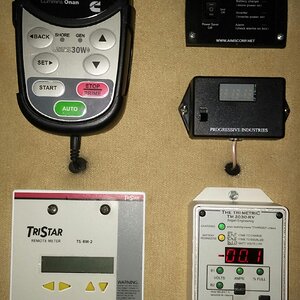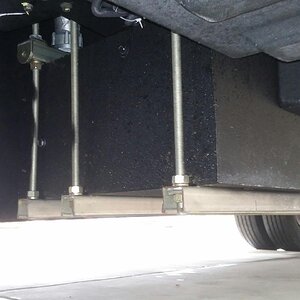I think this very important number is just too easily overlooked, as all those numbers become jumbled up.
My old trailer I no longer have had a dry weight and then a max weight, which the difference was the payload.
It had two axles at 3500 # each and 4 tires to carry that ENTIRE load.
If I added my max payload to the dry weight, my axles were undersized, I don't recall what each tire could carry, as it exceeded 7,000#.
But they told me you deduct your hitch weight, as your TV will carry that part of your trailers payload.
I was dumb and believed it, and about a year into towing the whole suspension and axles were wasted, and the tires rubbed the wheel wells.
Remember that load is not static, going over bumps, expansion joints, road/bridge settling, creates a down force, energy is exerted DOWNWARD on a already iffy setup.
It was fixed after lots of headache, and quickly traded in for a more stout and yet smaller travel trailer bumper pull.
Now folks seem to think that the load you put on your hitch can somehow disappear if you redirect it to the front steer axle, no it doesn't, it just redistributes it to 4 tires and two axles, the same weight is counted towards your TV payload, nor does it return some back to the trailer.
Think of the old teether totter as kids.
You had that fulcrum that carried all the weight on both kids and the equipment, it was balanced dead center, but if chubby got on while skinny was on one side, the loading shifted but the weight on the fulcrum stayed the same, if chubby moved closer to the fulcrum you could get an even distribution once again by redistributing his weight....
I am trying to convince a buddy he is exceeding his payload by way too much, but he isn't buying it because the truck is rated to "pull" more than the trailer weighs.
Shifting the trailer load behind the axles to lighten the hitch weight can add sway and also make your trailer bounce more, exerting that downward energy onto the hitch, which even raises the "load" to a temporary higher weigh/number that can strain an already iffy set up when it bounces up and down...... is it much, I don't know, but I know a heavier hammer can drive the same nail deeper and faster than a smaller one..... will the welds take that extra shock, for how long?
Now add speed to this equation.... YIKES.
I am at my wits end, and I am the one being too anal, as the conventional wisdom is that they "factor" in people pushing that line, and say if 1000# is ok, but 1001# isn't, then that just shows you its a point of reference and not to be taken to seriously....
What would you say?
My old trailer I no longer have had a dry weight and then a max weight, which the difference was the payload.
It had two axles at 3500 # each and 4 tires to carry that ENTIRE load.
If I added my max payload to the dry weight, my axles were undersized, I don't recall what each tire could carry, as it exceeded 7,000#.
But they told me you deduct your hitch weight, as your TV will carry that part of your trailers payload.
I was dumb and believed it, and about a year into towing the whole suspension and axles were wasted, and the tires rubbed the wheel wells.
Remember that load is not static, going over bumps, expansion joints, road/bridge settling, creates a down force, energy is exerted DOWNWARD on a already iffy setup.
It was fixed after lots of headache, and quickly traded in for a more stout and yet smaller travel trailer bumper pull.
Now folks seem to think that the load you put on your hitch can somehow disappear if you redirect it to the front steer axle, no it doesn't, it just redistributes it to 4 tires and two axles, the same weight is counted towards your TV payload, nor does it return some back to the trailer.
Think of the old teether totter as kids.
You had that fulcrum that carried all the weight on both kids and the equipment, it was balanced dead center, but if chubby got on while skinny was on one side, the loading shifted but the weight on the fulcrum stayed the same, if chubby moved closer to the fulcrum you could get an even distribution once again by redistributing his weight....
I am trying to convince a buddy he is exceeding his payload by way too much, but he isn't buying it because the truck is rated to "pull" more than the trailer weighs.
Shifting the trailer load behind the axles to lighten the hitch weight can add sway and also make your trailer bounce more, exerting that downward energy onto the hitch, which even raises the "load" to a temporary higher weigh/number that can strain an already iffy set up when it bounces up and down...... is it much, I don't know, but I know a heavier hammer can drive the same nail deeper and faster than a smaller one..... will the welds take that extra shock, for how long?
Now add speed to this equation.... YIKES.
I am at my wits end, and I am the one being too anal, as the conventional wisdom is that they "factor" in people pushing that line, and say if 1000# is ok, but 1001# isn't, then that just shows you its a point of reference and not to be taken to seriously....
What would you say?











